JAPANESE ECONOMY AFTER WORLD WAR II

The Japan’s postwar economy developed from the remnants of an industrial infrastructure that suffered widespread destruction during World War II. In 1952, at the close of the Allied Occupation, Japan was a “less-developed country,” with per capita consumption roughly one fifth that of the United States. Over the following two decades, Japan averaged an annual growth rate of 8 percent, enabling it to become the first country to move from “less developed” to “developed” status in the postwar era. The reasons for this include high rates of both personal savings and private sector facilities investment, a labor force with a strong work ethic, an ample supply of cheap oil, innovative technology, and effective government intervention in private-sector industries. Japan was a major beneficiary of the swift growth attained by the postwar world economy under the principles of free trade advanced by the International Monetary Fund and the General Agreement on Tariffs and Trade, and in 1968 its economy became the world’s second largest, following that of the United States. Between 1950 and 1970, the percentage of Japanese living in cities rose from 38 percent to 72 percent, swelling the industrial work force. [Source: Web-Japan, Ministry of Foreign Affairs, Japan]
The competitive strength of Japanese industry increased steadily, with exports growing, on average, 18.4 percent per year during the 1960s. After the mid-1960s, a current account balance surplus was achieved every year except for a couple years following the oil crisis of 1973. The economic growth in this era, supported by strong private-sector facilities investment based on a high personal savings ratio, was accompanied by significant changes in Japan’s industrial structure. Whereas formerly the mainstays of the economy were agriculture and light manufacturing, the focus shifted to heavy industry. Iron and steel, shipbuilding, machine tools, motor vehicles, and electronic devices came to dominate the industrial sector. In December 1960, Prime Minister Ikeda Hayato announced an income-doubling plan which set a goal of 7.8 percent annual growth during the decade of 1961--1970. Government economic planning aimed at expansion of the industrial base proved exceedingly successful, and by 1968 national income had doubled, achieving an average annual growth rate of 10 percent.
Throughout the postwar period, Japan's economy continued to boom, with results far outstripping expectations. Japan rapidly caught up with the West in foreign trade, gross national product (GNP), and general quality of life. These achievements were underscored by the 1964 Tokyo Olympic Games and the Osaka International Exposition (Expo '70) world's fair in 1970. [Source: Library of Congress]
In his 1979 book “ Japan as Number One “ Harvard’s Ezra Vogel proclaimed that “Japan has dealt more successfully with more of the basic problems of post-industrial society than any other country.” Perry Anderson wrote in the London Review of Books, “The Japanese themselves, he said, had been too modest about their achievements. It was time they realised that in the overall effectiveness of their institutions, they were ‘indisputably number one’ and time too that Americans woke up to the fact, and put their own house in order. Post-bubble, the book is no doubt remaindered in Japan. But at the time, Vogel’s flattery electrified sales.” [Source: Perry Anderson, London Review of Books, February 9, 2012]
Websites and Resources
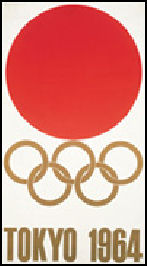
Good Websites and Sources on Post-War Japan : Wikipedia article on the Japanese Economic Miracle Wikipedia ; Jref Article on the Japanese Economic Miracle wa-pedia.com ; Long Blog Report on the Japanese Post-war economy dostoevskiansmiles.blogspot.com ; Yale Paper on the Economic Miracle econ.yale.edu ; Essay on Japan’s Rebirth at the 1964 Olympics aboutjapan.japansociety.org Wikipedia article on the Japanese Red Army Wikipedia ; Yukio Mishima's Suicide dennismichaeliannuzz.tripod.com/finalDay ; Wikipedia article on the Lockheed Scandal Wikipedia Post World-War-II Japan hartford-hwp.com Essay on Allied Occupation of Japan aboutjapan.japansociety.org ; Essay on Postwar Japan 1952-1989 aboutjapan.japansociety.org ; Essay on 20th Century Japan aboutjapan.japansociety.org ; Birth of the Constitution of Japan ndl.go.jp/constitution ; Constitution of Japan solon.org/Constitutions/Japan ; Takazawa Collection at the University of Hawaii on Social Japanese Social Movements takazawa.hawaii.edu ; Documents Related to Postwar Politics and International Relations ioc.u-tokyo.ac.jp ; Japan Echo, a Journal on Japanese Politics and Society japanecho.com; Books: “Making of Modern Japan” by Marius Jansen (2000);”Inventing Japan: (1853-1964)” by Ian Buruma (Weidenfeld & Nicholson, 2003). “ Embracing Defeat: Japan in the Wake of World War II” by John Dowser of Massachusetts Institute of Technology, who won the Pulitzer Prize for nonfiction in 1999.
Good Japanese History Websites: ; Wikipedia article on History of Japan Wikipedia ; Samurai Archives samurai-archives.com ; National Museum of Japanese History rekihaku.ac.jp ; Japanese History Documentation Project openhistory.org/jhdp ; Cambridge University Bibliography of Japanese History to 1912 ames.cam.ac.uk ; Sengoku Daimyo sengokudaimyo.co ; English Translations of Important Historical Documents hi.u-tokyo.ac.jp/iriki ; WWW-VL: History: Japan (semi good but dated source ) vlib.iue.it/history/asia/Japan ; Forums Delphi Forums, Good Discussion Group on Japanese History forums.delphiforums.com/samuraihistory ; Tousando tousando.proboards.com
RELATED ARTICLES IN THIS WEBSITE: MODERN HISTORY factsanddetails.com; ECONOMIC HISTORY factsanddetails.com; ECONOMIC HISTORY OF JAPAN FROM A.D 578 TO WORLD WAR II: THE WORLD'S OLDEST COMPANY, MEIJI PERIOD MODERNIZATION AND ZAIBATSU factsanddetails.com; JAPAN AFTER WORLD WAR II: HARDSHIPS, MACARTHUR, THE AMERICAN OCCUPATION AND REFORMS factsanddetails.com; JAPAN INTHE 1950s, 60s AND 70s UNDER YOSHIDA, IKEDA, SATO AND TANAKA factsanddetails.com; JAPAN BECOMES AN ECONOMIC POWERHOUSE IN THE 1970s AND 80s factsanddetails.com; JAPAN IN THE 1980s AND EARLY 1990s: NAKASONE AND THE PRIME MINISTERS THAT FOLLOWED HIM factsanddetails.com; JAPANESE BUBBLE ECONOMY IN THE 1980s AND ITS COLLAPSE IN THE 1990s factsanddetails.com; RECESSION, DEFLATION AND DECLINE FOLLOWING JAPAN'S BUBBLE ECONOMY COLLAPSE factsanddetails.com; JAPAN AND ITS PRIME MINISTERS AND GOVERNMENT IN THE 1990s AND EARLY 2000s factsanddetails.com; JUNICHIRO KOIZUMI factsanddetails.com; ECONOMIC REFORMS AND RECOVERY IN THE 2000s IN JAPAN factsanddetails.com; JAPAN, THE GLOBAL ECONOMIC CRISIS IN 2008 AND AFTERWARDS: HARD TIMES, STIMULUS AND SLIGHT RECOVERY factsanddetails.com; IMPACT OF THE MARCH 2011 EARTHQUAKE AND TSUNAMI ON THE JAPANESE ECONOMY, FACTORIES AND COMPANIES factsanddetails.com; ECONOMY AFTER THE MARCH 2011 TSUNAMI: RECOVERY AND SLOWDOWN IN 2012 factsanddetails.com; JAPAN'S DECLINE factsanddetails.com ABENOMICS: SHINZO ABE’S POLICIES TO TURN THE JAPANESE ECONOMY AROUND factsanddetails.com; SUCCESSES OF ABENOMICS factsanddetails.com; ABENOMICS OBSTACLES AND FAILURES factsanddetails.com
RECOMMENDED BOOKS: “Ashes to Awesome- Japan's 6,000-Day Economic Miracle” by Hiroshi Yoshikawa and Fred Uleman (2021) Amazon.com; “America and the Japanese Miracle: The Cold War Context of Japan's Postwar Economic Revival, 1950-1960 by Aaron Forsberg Amazon.com; “Inventing Japan: 1853-1964" by Ian Buruma (Modern Library, 2003) Amazon.com; “The Making of Modern Japan” by Marius B. Jansen Amazon.com; “The Cambridge History of Japan, Vol. 6: The Twentieth Century” by Peter Duus Amazon.com; “Hirohito and the Making of Modern Japan” by Herbert P Bix Amazon.com; “Embracing Defeat: Japan in the Wake of World War II” by John Dowser of Massachusetts Institute of Technology, who won the Pulitzer Prize for nonfiction in 1999. Amazon.com; “Japan Rearmed: The Politics of Military Power” by Sheila A. Smith (2019) Amazon.com; “Japan in Transformation, 1945–2020 by Jeff Kingston Amazon.com; “Blood and Rage: The Story of the Japanese Red Army (1990) by William R. Farrell Amazon.com
Economic Reforms in Japan after World War II
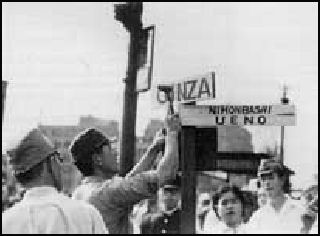
Putting up Roman
alphabet road signs After World War II, large zaibatsu included Mitsubishi and Sumitomo were broken up into hundreds of smaller companies and some of their heads were dismissed. Efforts to break up the zaibatsu — the the large industrial conglomerates that provided the hardware for Japan's military expansion — after World War II were resisted not only by the zaibatsuthemselves by conservative elements in the MacArthur headquarters.
Other economic reforms included the passage of Deconcentration Law and the establishment of the Fair Trade Commission. But in the end a desire by the United States to keep Japan as a good friend an unwillingness to rock the boat too much kept the “cordial oligarchy” between the government and the zaibatsu in place.
The economy was based more on a government-supported and corporation-patronized “social market” than a “free-market” like that of the United States. Government policies shifted vast amounts of wealth to the middle class. Labor was absorbed into corporate governance with an emphasis on employment security.
The revolutionary land reform bill that MacArthur pushed through the Diet allowed America-backed government to seized land and abolished the titles of the extensive aristocracy. The bill literally ended feudalism in many parts of Japan overnight and allowed many Japanese to own land for the first time.
The Japanese aristocracy was stripped of its land, wealth and status according to the terms of the post-war constitution. Large landowners were forced to sell their land to the tenants who worked it at a very reasonable price. On man from a noble family told the Washington Post, “After the war my mother had to cook for the first time."
MacArthur also helped smashed monopolies, break up the large corporations and prop up the unions. The zaibatsu were stripped of the powerful families that ran them but continued to exist.
Junichi Maruyama economic news editor of the Yomiuri Shimbun wrote: “The war put an end to the "bloc economy system" whereby world powers had kept their colonies enclosed within their own trading blocs, while setting up tariff barriers to keep external suppliers from soaking up internal demand. Instead, the world economy shifted to the Bretton Woods system of monetary management, with reduced tariff barriers and free trade as its foundations....Japan achieved remarkable reconstruction and rapid economic growth as a trading nation in the postwar years, chiefly due to the major changes in the framework of the international economy.”
Japanese Economy in the 1950s and 60s
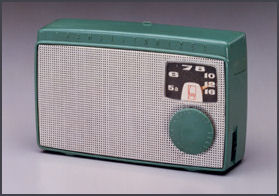
1955 Sony transistor radio In 1950, the per capita income of Japan was equal to that of Ethiopia and Somalia and 40 percent less than India. People were still dying of starvation. Photographs at Yasukina Shrine from the mid 1940s show families standing in front of shop windows "looking longingly" at toasters and refrigerators. In the 1950s, U.S. Secretary of State John Foster Dulles said, Japan "should not expect to find a big U.S. market because the Japanese don't make things we want."
After the end of World War II Japan strived to increase coal supplies to rebuild its industrial base. After securing energy supplies around the 1950s the national goal shifted to strengthen export capabilities.
In the 1950s and 1960s, Japanese bought black and white televisions, washing machines with ringers and ice candy from vendors roaming the streets on bicycles. Many people went out to the movies for entertainment.
The mass production of radios began soon after the first radio broadcasts in 1925. Televison mass production began in 1953. In the 1960s, the goal of many Japanese families was to obtain the “the three divine appliances”: the television, the refrigerator and washing machine. It wasn’t long before this was replaced by obtaining the three Cs: a color television, a car and a cooler (air conditioner).
Birth of the Japanese Economic Miracle

1963 Toyota A recovery program for Japan set up by the United States restricted imports, provided loans and encouraged personal savings and capital investment.
Japan expert Ian Buruma wrote in Newsweek that U.S. Secretary of State George Marshall decided that instead of setting up a Japan Marshal plan "Japan should be allowed to export is way out of trouble, and given the tools to do so. Vast amounts of U.S. taxpayers' money were transferred to rebuild Japanese industry. Japanese welfare spending was reduced, worker's wages cut and raw materials allocated to promote export jurisdiction over domestic consumption...And the task of rebuilding Japanese industry fell to those who knew best how to do it, the same bureaucrats and politicians who ran the Japanese war economy."
"Japanese liberals and leftist felt betrayed,' Buruma wrote. "But conservatives were delighted." The American plan "enabled them to build what they had always wanted: Japan as an economic superpower, monopolized by an elite of conservative politicians, bureaucrats and industrialists. The 'Marshall Plan' for Japan, in other words, set up Japan Inc."
The Korean War period was a boon for the Japanese economy. American ships were serviced in Japanese ports, machines were repaired, support facilities were established. Those who made a lot of money were fairly good at letting their wealth trickle down so that it improved the lives of ordinary Japanese not just the elite.
Rise of the Japanese Economy
With Washington taking care of security, Japan was able to focus its energy on becoming an economic powerhouse. By 1951 the Japanese gross national product had revived to pre-war levels, and Japanese businessmen had begun roaming through American factories with little supervision, picking up technical knowledge.
Japan's economic ascension had three distinct stages. The first stage was guided by the "priority production system" of the 1950s that stressed increasing coal and steel output and developing heavy industries like shipbuilding and timber making. In the second stage in the 1960s and 70s Japan focused on producing consumer products and automobiles for export markets. The third stage was the development of knowledge-based products like computers and electronics. [Source: Ian Buruma, Newsweek]
Japan's rapid economic growth began after it joined the IMF and the World Bank in 1952. Low-interest, long-term lending by the World Bank helped to accelerate the development of energy, industrial, transport and other infrastructure systems. World Bank lending began with the 1953 construction of Kansai Electric Power Co.'s Tanagawa thermal power plant in Osaka Prefecture. The plant was decommissioned in 2001. The loans totaled 863 million dollars, or 310 billion yen at the then fixed rate of 360 yen per dollar. The 31 projects included the construction of a Toyota Motor Corp. factory at its present-day headquarters, the Tokaido Shinkansen system between Tokyo and Osaka, and the Tomei Expressway between Tokyo and Nagoya.[Source: Jiji Press, October 8, 2012]
The Japanese went through a stage similar to the one that China is going through now in terms of copying and piracy. In the early stages of their development Japanese companies copied many American and European products. These companies and the Japanese government became more concerned with intellectual property concerns when Japanese companies needed laws to protect their patents and copyrights.
Japan’s talent for “monozukuri” (“thing making”) has been a key to its success. Many businesses got their start in one room neighborhood factories, relying on cheap labor, that made textiles, toys, tools and cheap electronic items. The first Sony portable transistor radio appeared in 1955 and the first Barbie dolls were produced in Japan in 1959.
Early Japanese products were ridiculed as cheap imitations and many companies made awful mistakes. Datsun, for example, named its first American cars the "Bluebird," as in the "bluebird of happiness." The car failed miserably in a market dominated by Thunderbirds, Mustangs and Barracudas.
Prime Minister Shigeru Yoshida (1878-1967) led Japan during the postwar period. He was known as the “postwar one man” prime minister. He established a security relationship with the United States and laid the foundation for the postwar recovery by pursuing a “Light armament and economy-first policy.”
Rapid Growth in Japan in the 1960s
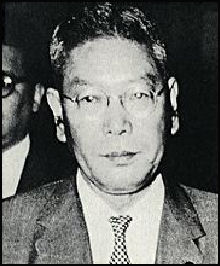
Prime Minister Ikeda In 1960, Prime Minister Hayato Ikeda, regarded as Japan's most charismatic postwar prime minister, challenged Japan to double its income in the next decade, ushering in a long period of growth that didn't stall until the oil crisis of 1973. The 58 month period of sustained growth between November 1965 and July 1970 is known as the “Izanagi” boom.
Under Ikeda’s Income Doubling Plan the national GNP was to be doubled through a program in which consumption was boosted by cutting taxes, bolstering welfare, raising farm prices and reducing income equality. In the 1960s even American soldiers could start valuable collections of Japanese art with their meager salaries and raise families thanks to the favorable value of the yen ( ¥360 to the dollar).
Through the 1960s, Japan had a growth rate of 11 percent (compared to 4.6 percent in West Germany and 4.3 percent in the United States and comparable to the growth rates China has achieved in the 1990s and 2000s), fueled by vigorous investment of private industry in new plants and equipment; a high rate of saving by Japanese households, which provided banks with funds for investment; and the availability of an abundant labor force with a high level of education.
Many ordinary Japanese aspired to get their hands on the "three Cs"”a car, an air conditioner and a color TV. Between 1965 and 1970 the number of households that owned a car jumped from 1 in 20 to 1 in 5. By 1970, 19 out of 20 owned a television.
Protectionism by the United States allowed Japanese companies stop focusing on producing consumer goods and concentrate more on making big things like cars. By 1970, Japan was the third largest industrial nation in the world after the United States and the Soviet Union. Spurred by the Income-Doubling plan of 1960, Japan became the world’s second-largest economy, strong enough to weather the energy crisis and oil shock of the mid 1970s.
Japan surpassed Germany to became the world’s second largest economy in 1968. Japan had the world’s second-largest economy through the 1970s, 80s, 90s, 2000s until it was surpassed by China in 2010. Japan's status changed to that of a donor country after it stopped receiving new loans from the World Bank in 1967. It has since become the second-largest shareholder in the IMF and the World Bank, extending aid to developing countries and addressing international financial crises.
Japan in 1964
In September 1964, when the International Monetary Fund and the World Bank held their annual meetings in Tokyo, participants from around the world witnessed a Japan that had dramatically transformed from a war-ravaged country to a major economic power. Forty-eight years later, Japan will host the IMF-World Bank annual meetings this week for the second time. This time, the country is striving for a "second rebirth" following hard economic times and a catastrophic natural disaster. [Source: Jiji Press, October 8, 2012]
The 1964 IMF-World Bank meetings, along with the Tokyo Olympics the same year, provided a great opportunity for Japan to impress the world with its dramatic recovery following defeat in World War II. Hosting the meetings was "more effective than holding 100 international trade shows," said then Finance Minister Kakuei Tanaka, who later became prime minister. Tanaka was so enthusiastic about promoting Japan Inc. that he delivered a speech in English after studying the language intensively.
In 1964, the country's gross domestic product expanded by 17.6 percent in nominal terms to 30 trillion yen, with growth at 11.2 percent in price-adjusted real terms. The unemployment rate was 1.1 percent. That year, on the back of the booming economy, Japan joined the Organization for Economic Cooperation and Development, often considered a rich-country club.
"We were heavily committed to preparing for the [IMF-World Bank] meetings, and we were excited that Japan was in the international limelight," recalls Takatoshi Kato, who was a lowly Finance Ministry official in 1964. He is now president of the Japan Center for International Finance.
Kakuei Tanaka and Iron Triangles
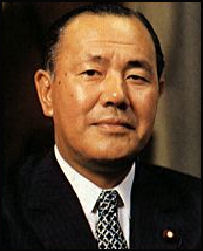
Prime Minister Tanaka Japanese politics in the 1960s and 1970s was dominated by charismatic and corrupt prime minister Kakuei Tanaka, who was credited with creating Japan Inc. and keeping the Liberal Democratic Party in power through a patronage system described as "Iron Triangles."
Tanaka was a populist hero who sang folk songs and appealed to ordinary Japanese. He was nicknamed the "Human Bulldozer" for his fondness for expensive public works projects including one system of roads that allowed him to drive from his office in Tokyo to his office in Niigata, a journey of four hours, making only three turns. Under his stewardship 10-year public works expenditures tripled from $37 billion to $105 billion.
The American writer Richard Katz wrote that Tanaka melded "the corruption of a Ferdinand Marcos and the interest-based politics of a Richard Daley." He made Japan Inc. into a global business powerhouse with his program to "Rebuild the Japanese Archipelago" and forged "Iron Triangles” between business, the bureaucracy and the Liberal Democratic Party. The cornerstone of Iron Triangle patronage system was getting government ministries to approve huge public works programs and granting the contracts to construction companies which employed retired bureaucrats and LDP loyalists and supported the LPD further by getting out the vote for the LDP in the areas where they were based.
Oil Embargo and Growth in Japan in the 1970s and 80s
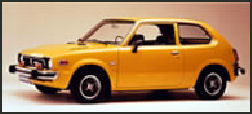
1974 Honda Civic Japan went into a severe recession in 1974 and 1975 after the Arab oil embargo. GDP shrunk 0.5 percent in fiscal 1974 and 4 percent in fiscal 1975 with the worse drop of 13.1 percent occurring the January-March 1974 quarter.
In 1973 the Japanese economy was suffering an inflation spiral caused mainly by surging land prices triggered by a nationwide development boom. In October of that year, war broke out in the Middle East and Arab oil-producing nation cut supplies to countries that supported Israel. Oil prices quadrupled, consumption declined and high raw material costs hit companies hard.
Again in 1980 Japan suffered from high inflation and recession mainly due to large hikes in the price of imported oil. The exchange rate reaches 360 yen to the dollar in the 1970s.
Even so economic growth continued at a robust rate through the 1970s and 80s, with the growth in the 1980s about 5 percent a year, about half the growth rate that China experienced in the 2000s. With the help of the oil embargo Japan captured 21 percent of the world's automobile market by the mid 1970s.
By the 1980s, Japan had built up such huge trade surpluses and the yen had become so strong that Japanese businessmen were buying up properties all over the world and Japanese tourists were fanning out to every corner of the globe. Many people thought Japan was poised to dominate the world economically and Japan bashing became a popular conversation topic in the United States and elsewhere.
Image Sources: 1) 4) 5) Currency Museum of the Bank of Japan 2) British Museum 3) Wikipedia 8) Sony 9) Toyota 10), 11) Kantei, office of prime minister 12) Honda
Text Sources: New York Times, Washington Post, Los Angeles Times, Daily Yomiuri, Times of London, Japan National Tourist Organization (JNTO), National Geographic, The New Yorker, Time, Newsweek, Reuters, AP, Lonely Planet Guides, Compton’s Encyclopedia and various books and other publications.
Last updated January 2013
